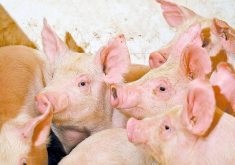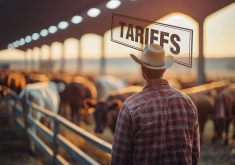Herd parity profile influences both the physical and economic performance of sow herds and yet many herds fail to achieve a sufficiently high average herd age, says Dr. Juan Carlos Pinilla with PIC North America. Speaking at the recent Manitoba Swine Seminar, he said that attention to the factors that influence parity structure is essential to optimize profitability, in particular keeping culling rate at an acceptable level.
Pinilla suggests a target of 50 per cent annual replacement rate, with 44 per cent culling rate and six per cent death loss. Assuming 2.5 litters weaned per sow, this will result in an average herd parity of 3.5 and an average age at removal of parity 5. Producers should also aim to have at least 50 per cent of sows in the parity 2 to 5 range, he says.
Read Also

Horns aren’t unlocking anytime soon on livestock transport standards
Standards good enough meet the definition of “humane” animal transportation still vary widely between what what industry wants, what animal rights advocates want and, between the two, what federal regulators decide is good enough.
Understanding why, when and how sows are removed from the farm is the first step to establish corrective actions when there are deviations from the targets, he says.
“It is essential to train farm personnel in the correct identification of the reasons for sow mortality and culling. It is common to see 30 or even more culling reasons in a system, so training and expertise can reduce the number of reasons that different farms are currently reporting.” Making sure that destroyed females are included in the records as part of the sow mortality is also important so that they are not added into the culling numbers, Pinilla adds.
CULLING AND PARITY PROFILE
A review of culling records from a total of 50 sow farms in the Midwest, with an inventory of more than 180,000 sows, revealed that almost a third of the females are unable to wean more than three litters before culling. This suggests a need to look for management procedures and health programs which allow pig producers to capitalize on the benefits of higher sow retention rates and consequently a more mature sow herd, Pinilla says.
“Farms not retaining 70 per cent or more of bred gilts through to parity 3 are not able to consistently hit the targets for replacement rate and average removal age,” Pinilla says. “This emphasizes that producing enough high-quality gilts is a key element of any plan to have the right parity profile.”
The most important single factor that makes gilts eligible to be bred is body weight but in reality few sow herds can weigh gilts, Pinilla notes. Thus, flank taping or gilt age are the most common methods to estimate eligibility.
“When comparing age at first breeding versus culling rate from breeding to first weaning it is noticed that removal rate remains constant in gilts first bred from 28 weeks of age until 31 weeks of age,” he explains. “From 32 weeks of age, there is an increased culling rate. It is unclear why older gilts tend to have a shorter productive life; however it can be speculated that they were bred late in life due to limitations in growth rate, in their reproductive ability, or both.”
Pinilla says that from selection, gilts should be raised in no less than 12 sq. ft per gilt to ensure proper growth rate and make the heat detection simpler. To maximize the number of eligible gilts from any given batch, they should be provided with a dry environment, non-slippery floor, full feed, one drinker per every 15 gilts and daily boar exposure to a mature boar for at least six weeks prior to the actual first breeding.
Pinilla says it is also important to acclimatize gilts to a stall and being fed only once or twice a day for a minimum of 15 days before breeding, Pinilla adds, otherwise first litter size may be reduced by 0.5 to 1.0 pigs.
Pinilla notes that there are often large variations in sow retention rate within systems, even though most aspects of the production system are the same. “Factors like annual feed usage and body condition, labour turnover and qualifications, staff motivation, herd health and facility layout should be investigated as potential risk factors,” he says.
ECONOMICS
Young females removed from the herd are not fully amortized so they increase the cost of the weaned pig, Pinilla points out.
“These young females are replaced by even younger females, adding the cost of additional replacement rate to the challenges on production associated with lower immunity against reproductive diseases and digestive diseases, lower litter birth and weaning weights, and potentially compromising pigs’ performance after weaning.”
In an expensive feed ingredient environment, sows enter into positive margins later in life, says Pinilla. “In a model based on cost of production of $29/weaned piglet, 11.1 weaned piglets per litter and a purchase price of $200/gilt, females remain in negative margin until P-3 and start to move into positive territory at P-4 (Figure 1). They gain in economic advantage until P-5, remaining in this area until P-7. After that, there is no advantage to retain them in the farm.”














